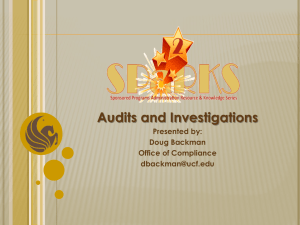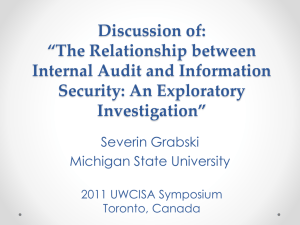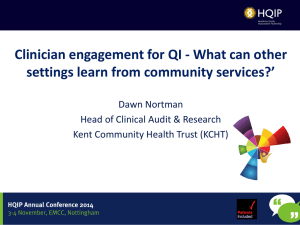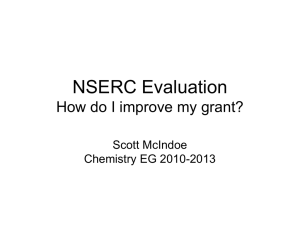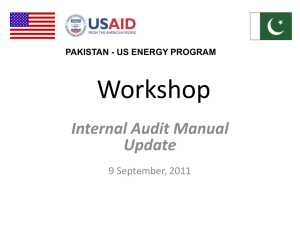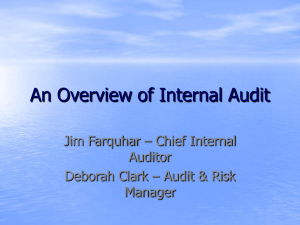Diane Stemper - Nebraska Association of Student Financial Aid
advertisement
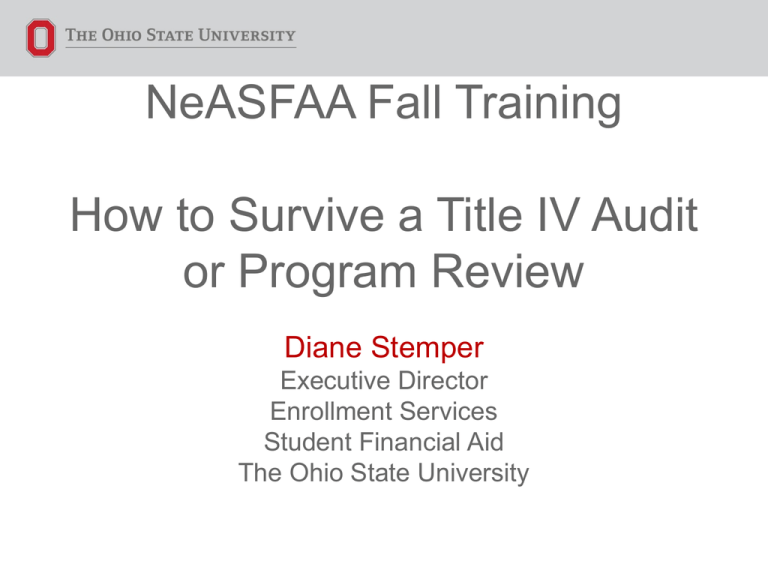
NeASFAA Fall Training How to Survive a Title IV Audit or Program Review Diane Stemper Executive Director Enrollment Services Student Financial Aid The Ohio State University Agenda Federal Program Review and Audits What are they? Why? Preparation While audit is occurring - expectations Completion of audit and findings Next steps Enrollment Services What are Program Reviews and Title IV Audits? Why do we have to endure a U.S. Department of Education Program Review? Authority for Program Reviews is defined by Congress to ED to ensure necessary oversight of Title IV institutional participants Section 498A (administrative capability & financial responsibility) “Why?” Purpose is to evaluate compliance, identify liabilities/risks, and enhance institutional administrative capabilities Ensure the efficient and effective use of taxpayer dollars in support of American education Identify financial aid compliance risks and financial liability Make conclusions and recommendations Determine corrective action Types of Audits •Public & Non-Profit Institutions: A-133 Due within 9 months of the fiscal year end (FYE) date (-More requirements, more time) •For-Profit Institutions: SFA Audit Guide Due within 6 months of the fiscal year end (FYE) date Schools must arrange for regular independent audits that include the operation of the FSA programs. Types of Audits and Reviews Focused Full Scope Program Review Triggers High cohort default rate Significant changes in Direct Loan or Pell volume Late refunds Deficiencies reported by state licensing or accrediting agencies Financial responsibility standards High withdrawal rates Significant audit findings Repeat findings or recurrent problems Significant risk of noncompliance with administrative capability Complaints from students or adverse publicity Institutions that haven’t had a review in a number of years Frequent change in financial aid leadership ED’s Goals Identify any institutional weakness(es) Frame required actions to strengthen institutional compliance Quantify harm of noncompliance Administrative action to protect students and taxpayers Institutional Goals Understand and ensure compliance with Program Review requirements Respond as quickly and accurately as possible to the multiple data requests prior to the on-site visit Remain professional throughout the site visit and at all times (email, phone, etc.) Manage the Program Review and follow-up to mitigate liabilities and administrative action Positives of a Program Review Increase visibility of our complex financial aid world (one campus even received additional staff after their Review) Raise awareness of Federal Title IV compliance as a campus-wide responsibility Learn what you are doing right! Assess and make focused improvements/enhancements Mitigate liabilities and administrative actions You’ve Been Selected You’ve Received a Letter Don’t Panic Remember that auditors and reviewers are financial partners Read the letter carefully Contact the reviewer Notify senior campus officials immediately Discuss with staff Provide overview of what to expect Program Review Timeline 2-4 weeks advanced notice (but sometimes very short notice, especially in cases of serious complaints or adverse media) Typically 1 week on-campus Written report 1-6 months later School response due in 30 days Final Determination Letter (or, in cases of few or no findings, an expedited Determination Letter) Appeal process PREPARATION Institutional Responsibility President’s Office Bursar Financial Aid Admissions Registrar “Point” Person 3rd Party Servicers How to Prepare Read the 2009 ED Program Review Guide http://www.ifap.ed.gov/programrevguide/2009Progra mReviewGuide.html Review the sample file and policy review checklists Review and prepare for sample student/staff interview questions Obtain outside help if needed Rally the Resources Identify key staff to compile required documents – share the responsibility Pull files Conduct individual interviews as needed Resolve issues Prepare to provide copies of entire student records (FA files, admission applications, student records, academic transcripts, student account files, R2T4 calculations/payments, etc.) Internal Reviews Locate a Program Participation Agreement (PPA) and Eligibility and Certification Approval Report (ECAR) Review prior audits Standard of Administrative Capability (34 CFR 668.16) Corrective Action Plan (CAP) should have indicated corrective steps taken What procedures are in place? Make sure prior deficiencies are addressed! Tools of the Trade FSA Handbook ISIR Guide Dear Colleague Letters Federal Registers Code of Federal Regulations FSA Assessment Tool NASFAA Standards of Excellence Review NASFAA Self-Evaluation Guide The Blue Book Preparation for Audit Review operational practices Review and update policy and procedures documents for packaging Conduct training sessions on regulatory changes, ongoing reminders and compliance information Requested Documents Include: Policies and Procedures Manual Sample FSA forms Cost of Attendance Budgets Pell Electronic Statement of Account (ESOA) Information Return to Title IV (R2T4) worksheets Documentation of cash requests/refunds/returns Default management plan, if required FISAP Satisfactory Academic Program and refund policies Requested Documents Include: ISIRs Latest accreditation status Third party servicer contracts Administrative software utilized Program Participation Agreement (PPA) and Eligibility and Certification Approval Report (ECAR) Financial statements for past two years Campus security report Catalog Consumer information Specific Prep Items Chart of accounts/funds information Control/process memos List of trainings and in-services for staff Policies for notifying ED and NSLDS of student status change Reciprocity students Cost of Attendance (COA) budgets Compensation plans Recruiting policies Satisfactory Academic Progress & Academic progress Consortium or other program agreements MOAs Program Review and Audit: Helpful Hints Provide single point of contact Ask for requests in writing or confirm understanding in writing for clarity Keep copies of everything provided: you will look at the stuff again Provide a comfortable place for reviewers to work Respond promptly to requests Do not answer the “unasked” question Challenge findings Managing the Visit Give the Program Reviewers space, but be available and check in periodically to see if anything is needed Keep detailed notes of all questions, follow-ups, documents provided Track open items and resolutions If possible, have your staff review COD and NSLDS records of student sample group before the visit (or as soon as you receive the list) Entrance Interview President/Chancellor Vice President(s)/Provost Directors of key departments (Bursar, Admissions, Comptroller, Chief Fiscal Officer(s), Internal Audit) Entrance Interview Overview Welcome and introductions Program Reviewers will explain to the group: The purpose of the Review The scope of the Review The Timeframe, including the date/time of the Exit Interview (typically with the same invitees) Clarify the campus operating parameters (hours of access to campus personnel) for Program Reviewers Clarify who Program Reviewers will need to meet with Remain professional, courteous and cautious responding only to what is requested (and prepare others accordingly) Exit Interview Advise campus colleague attendees of any preliminary issues you may be aware of before the Exit Interview Ask a campus colleague to take detailed notes Ask for regulatory citations for any issues you may question Prepare your own list of questions for the Program Reviewers Discuss any findings or unresolved issues appropriately – it is ok to ask questions (but don’t be confrontational) 50 Ways to Survive a Federal Title IV Program Advise legal counsel of the visit in case they are needed Do everything you can to maximize the success of the review – do not feel bad about asking staff or key responders to reschedule/postpone leave or appointments to accommodate the review – this is important stuff You will need help – ask for it and keep asking until you get it! Trust that you know things Remember that no one knows everything, especially immediately from memory Stress that everyone involved should keep notes on all conversations of substance Ease tension for financial aid staff and other core responders by meeting to discuss the review Listen more, talk less DON’T ANSWER QUESTIONS THAT ARE NOT ASKED 50 Ways to Survive a Federal Title IV Program Be sure you understand any questions before trying to answer An honest answer to any question is all that is needed– however, do not answer when you don’t know (no guessing!) or unnecessarily expand an answer – it’s okay to say “I’d like to get back to you on that” Ask questions; respectfully disagree – a reviewer may not be an expert in every area of financial aid (like systems) Keep organized; if you have the option, use an “assistant” Don’t treat reviewers like the enemy; be cautious but professional Establish a congenial working relationship with the reviewers Assume there will be findings 50 Ways to Survive a Federal Title IV Program When discussing findings, ask questions if you are unclear – you can state “do not concur” You will have a good sense of what will be shared at the exit interview - prepare those who will attend no matter how negative the findings – it is much better to hear it from you first than in a group setting with the reviewers During review ask for regulatory/statutory citations and make sure you understand how they apply to the findings Make sure you keep all reviewed materials together to ensure you know what reviewers saw at the time of the review Completion of Audit Understand findings so corrective action can occur Write responses in timely fashion, involve other units Potential items: Inaccurate/untimely reporting of enrollment status Attendance first day (distance vs. non-distance) Withdrawal date Earn and unearned “F” grade Grade level information, notification of Full-time/part-time documented Degree progress Course repeat rules enforced Frequent Audit Findings Auditor opinion cited in audit (qualified or adverse) Verification violations Pell over/under payments Student Credit Balance deficiencies Student confirmation report filed late/not filed/not retained for five years/inaccurate Return of Title IV late, calculation errors Entrance/Exit Counseling Repeat finding – failure to take corrective action Student Status – inaccurate/untimely reporting Most Frequent Program Review Findings Verification Crime awareness reporting Return of Title IV late, calculation errors Entrance/Exit Counseling SAP Student Credit Balance deficiencies Missing or inconsistent information in student files Pell over/under payments Ineligible Pell disbursement Most Frequent Program Review Findings Consumer information deficiencies Improper dependency overrides Lack of administrative capabilities Improper Certification of Student Loans Repeat finding – failure to take corrective action Student Status – inaccurate/untimely reporting Some additional recent findings: FWS students paid for time they were scheduled for class Documenting Pell recipients’ initial attendance and/or documenting dropping a class and reducing Pell accordingly Findings on Both Lists Return of Title IV late, calculation errors Entrance/Exit Counseling deficiencies Verification violations Pell Grant over/underpayments Student Credit Balance deficiencies Repeat finding – failure to take corrective action Student Status – inaccurate/untimely reporting Next Steps Create priority list for implementation of correcting findings Create an implementation timeline Review frequently Online Resources Top 10 Audit and Program Review Findings: http://www.nasfaa.org/Main/orig/2012/Top_10_Audit_and_Program_R eview_Findings.aspx Compliance Resources for Financial Aid Professionals: http://www.nasfaa.org/compliance/ Program Review Guide for Institutions 2009: http://ifap.ed.gov/programrevguide/attachments/2009ProgramR eviewGuide.pdf Successfully Managing a Program Review (again, much of today’s slide deck came from this NASFAA presentation): http://www.nasfaa.org/EntrancePDF.aspx?id=2595 FSA Handbook, Volume 2, Chapter 9, “Program Reviews, Sanctions & Closeout” http://ifap.ed.gov/fsahandbook/attachments/1112FSAHbkVol2Ch9.pd f Moving Forward – OSU QA Model Compliance Quality Assurance Training Questions? Thank you! Diane Stemper DStemper@esue.ohio-state.edu


